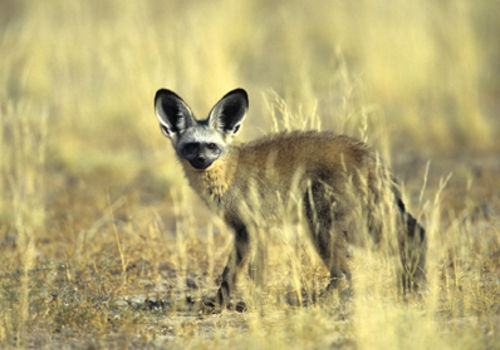
Bat eared fox
Otocyon megalotisBat eared fox
Introduction: The bat-eared fox (Otocyon megalotis) is so named because of its large ears, which are characteristic of the species. They belong to the same family as jackals and resemble them, but are smaller. Other characteristic features are the broadly black tipped bushy tail (around 25cm long) and black limbs.
They are monogamous creatures and can often be found in groups comprising of just a mated pair and their offspring. Predators of the fox include large birds of prey, spotted hyenas and larger cats. If a family member is caught, other bat-eared foxes will attempt to rescue it by bravely attacking the predator using harassment techniques which include ankle-biting.
Although not noisy animals they can also be heard calling one another with a shrill 'who-who-who' calls. They mark their territorial boundaries by urinating on bushes and trees. The bat-eared fox is an endangered species, mainly due to the trade in their skins.
Distribution: Bat-eared foxes are found across all of Namibia. They have also been seen in Nxai Pan in Botswana. They are known to follow the rains, which coincide with plentiful insect activity. They favour short grass with bare patches, instead of dense bush.
Diet: The massive ears of the bat-eared fox allow it to detect invertebrates below ground. It will then dig frantically to unearth its favourite meal – termites. It also feeds on other insects such as beetles, small rodents, lizards, small snakes and wild fruit.
Colouring: Their fur is a beautiful silver-grey colour.
Breeding: Cubs are born after a gestation period of about 2 months and females often give birth around October and November, a time marked by increased insect numbers due to a break in the rains. An average litter is between 4-6, although a heavy mortality rate has been observed due to predators, mainly brown hyena.
Size: The bat-eared fox has a shoulder height of only 30cm, a length of about 75cm and weighs less than 5kgs.
Klein Windhoek

